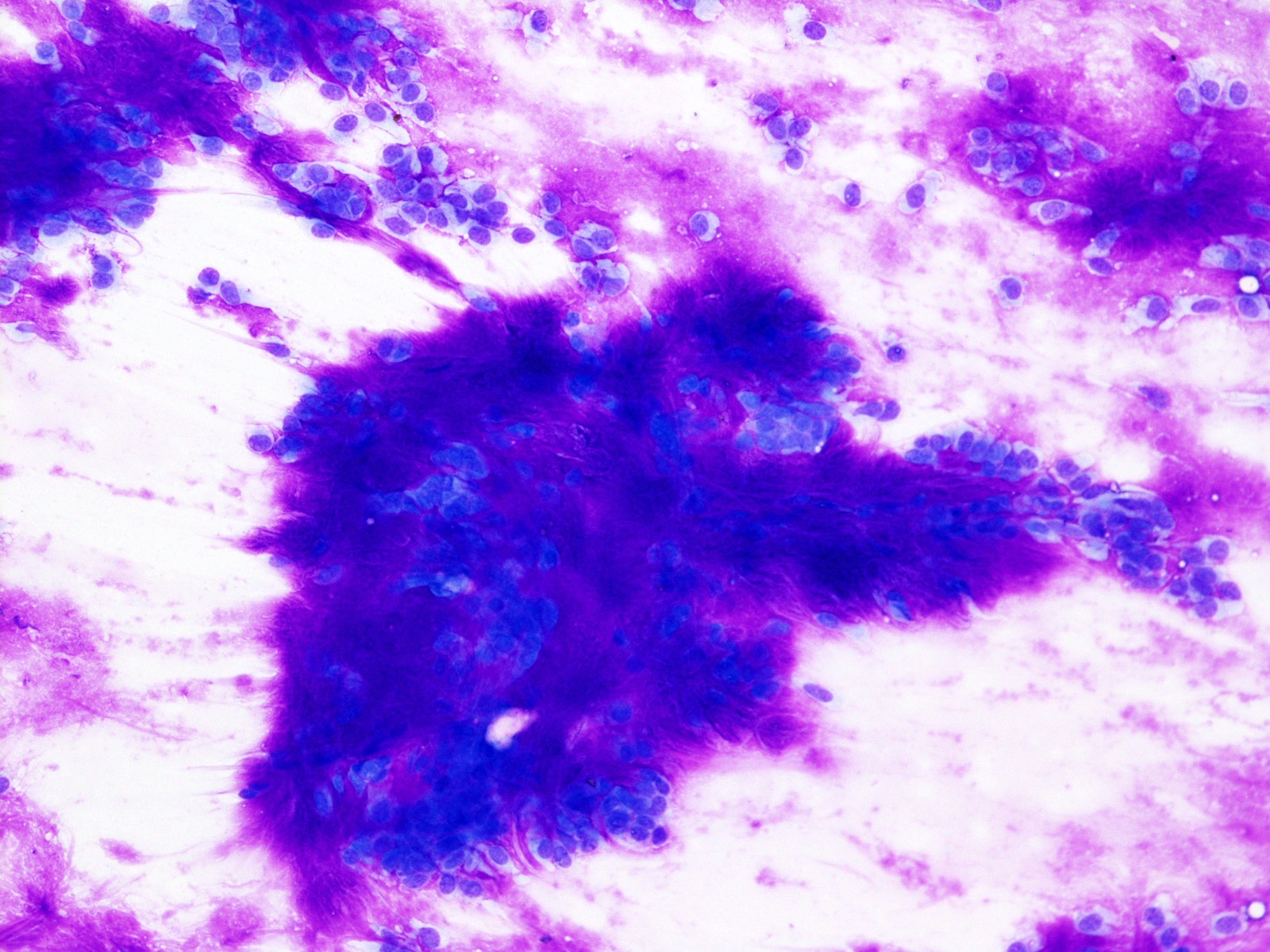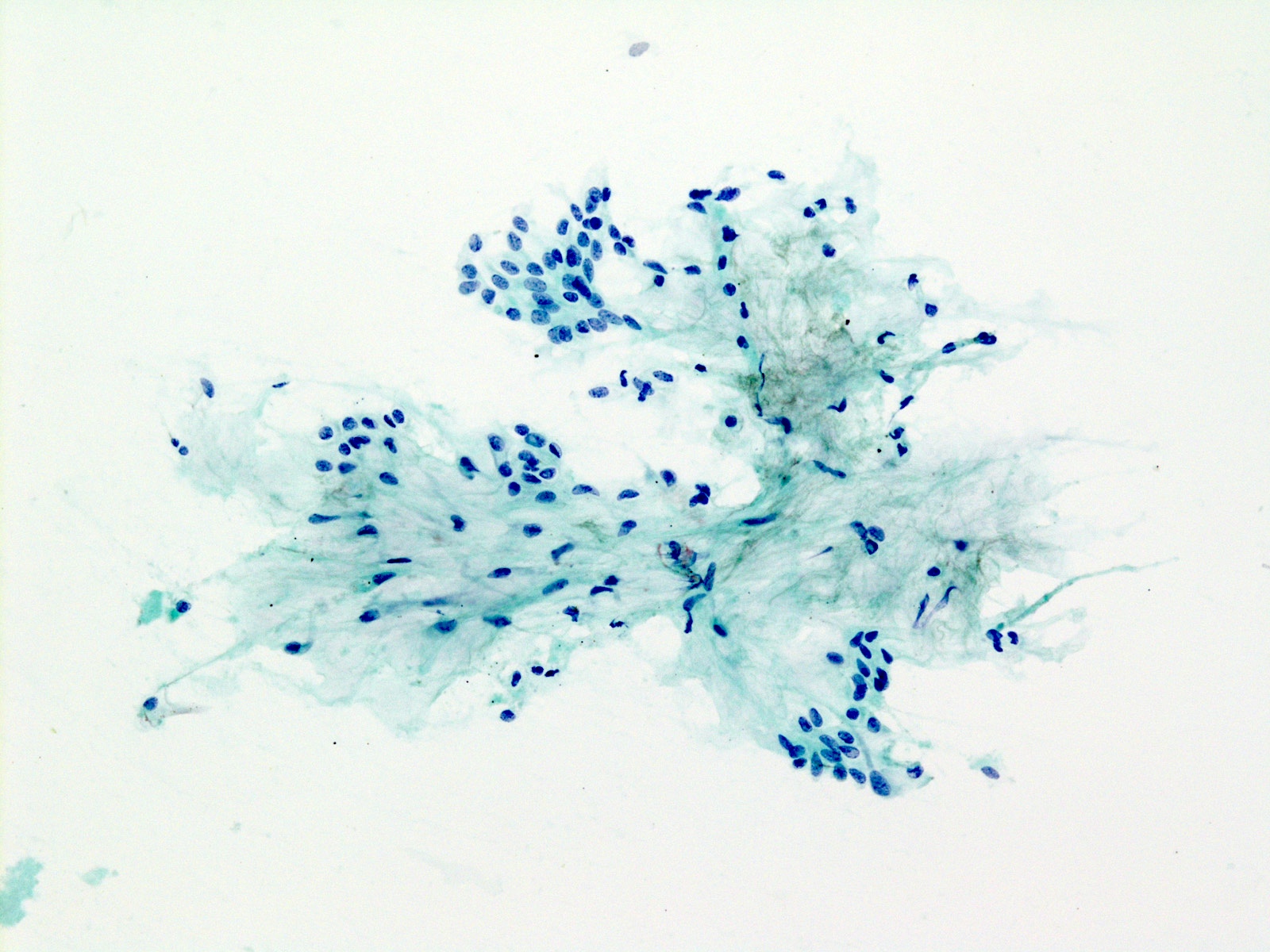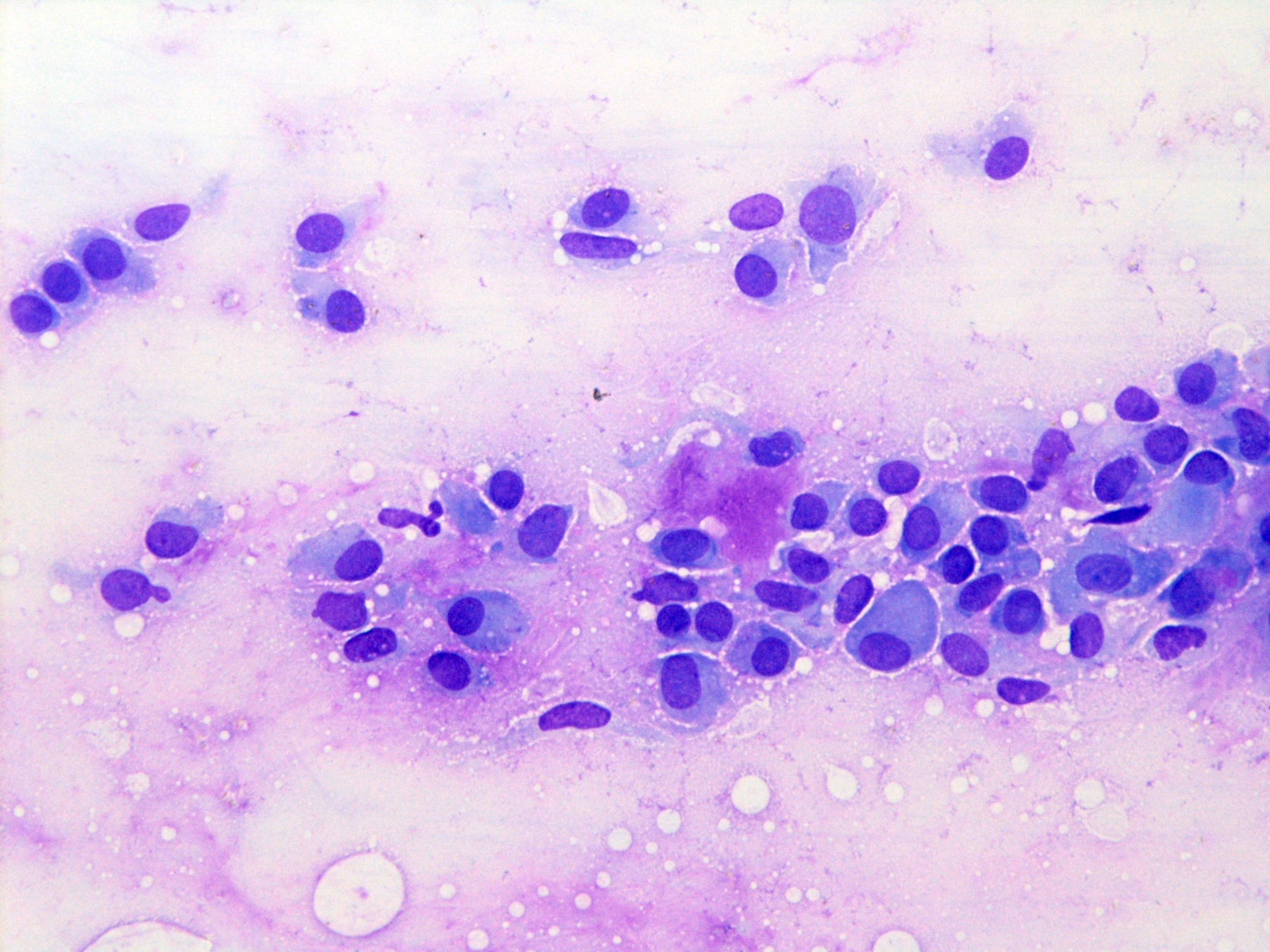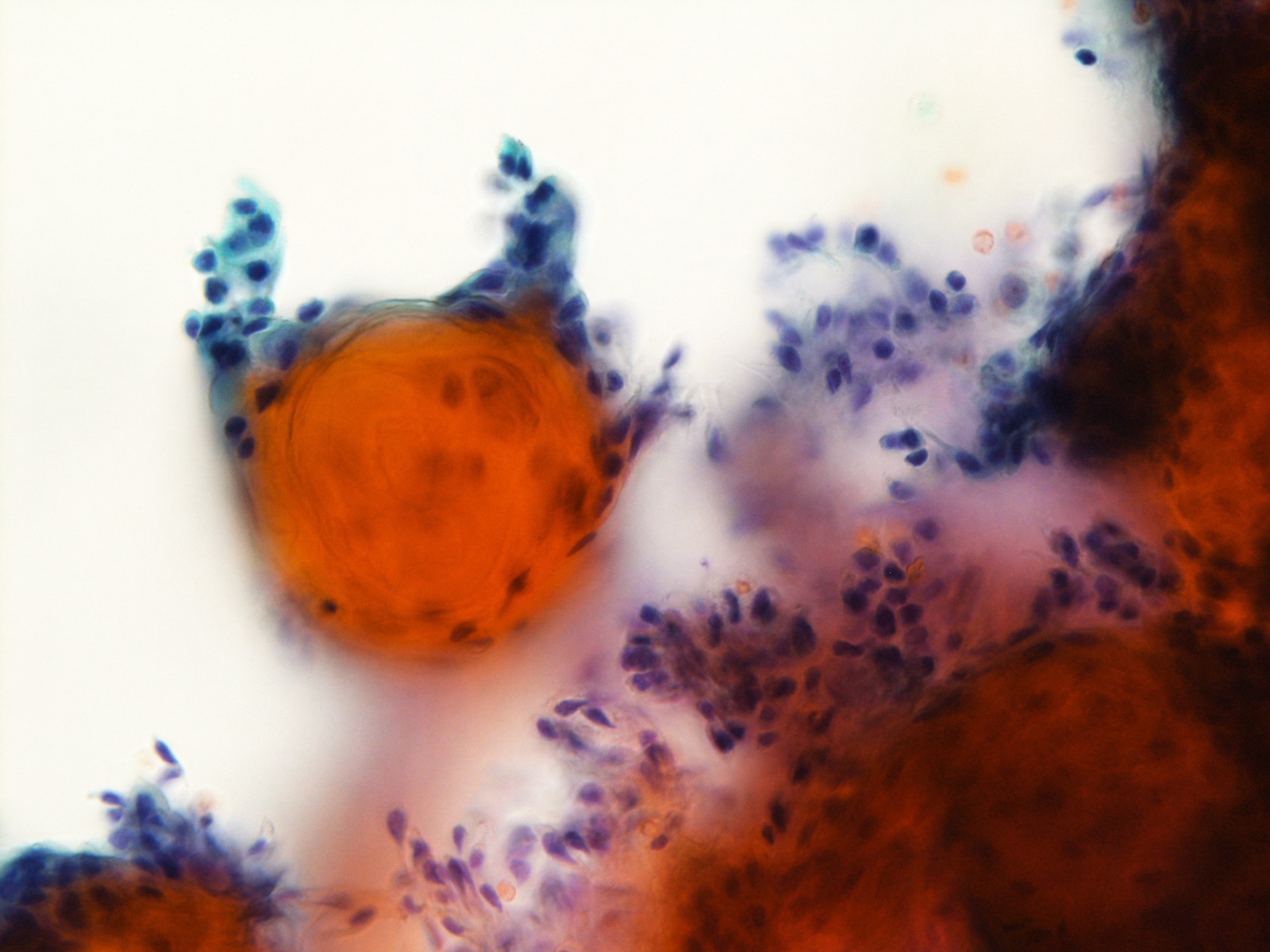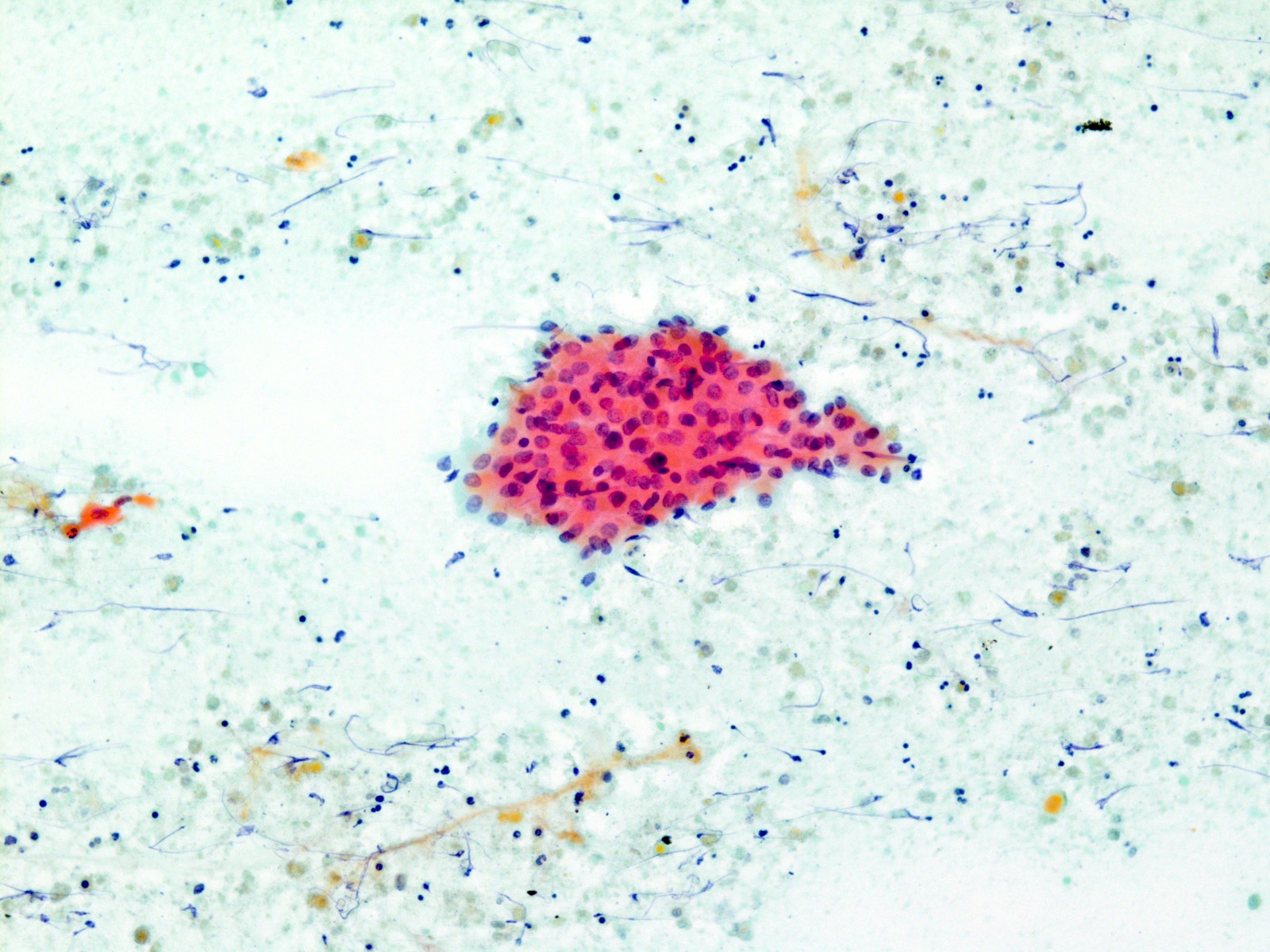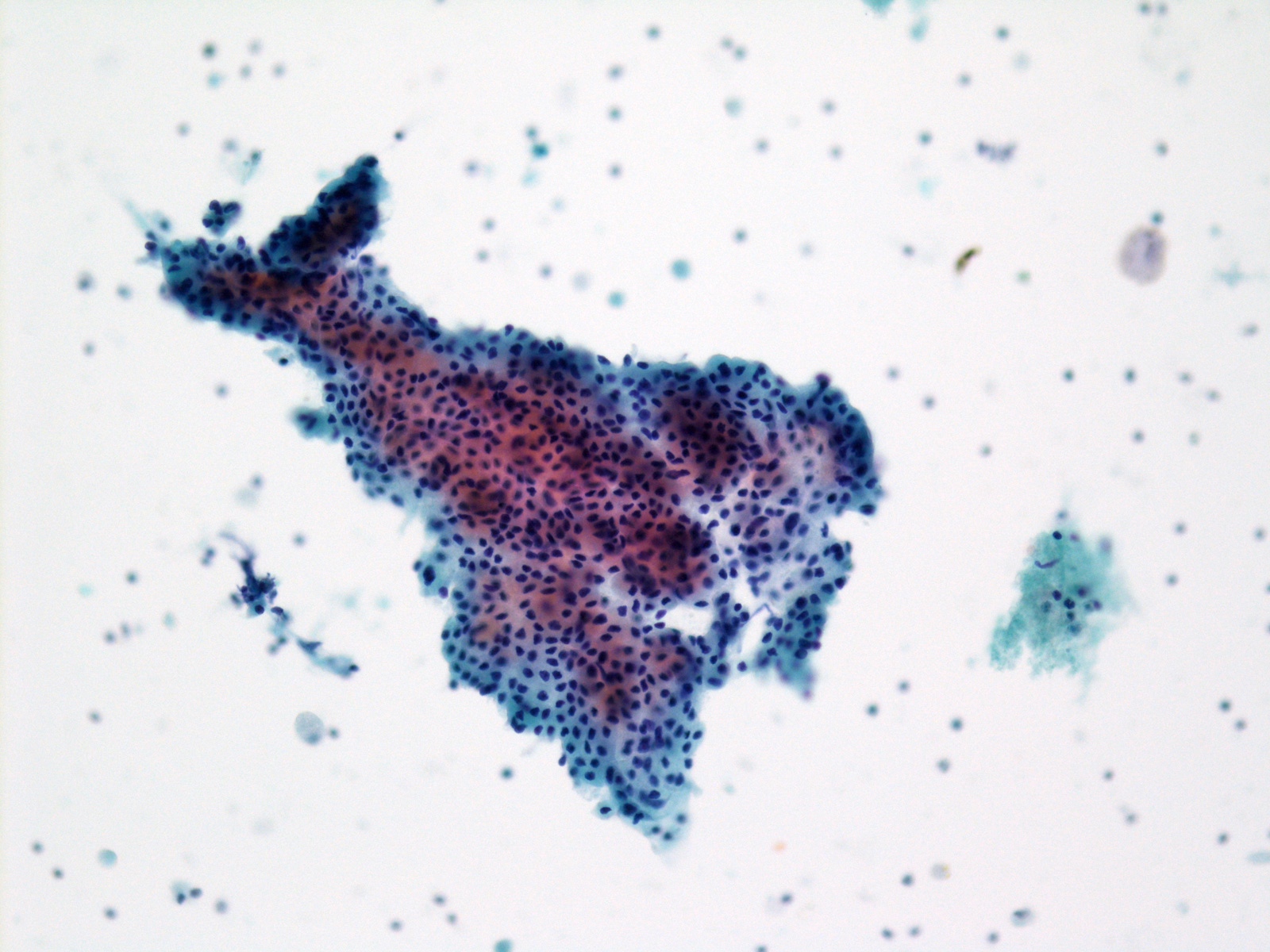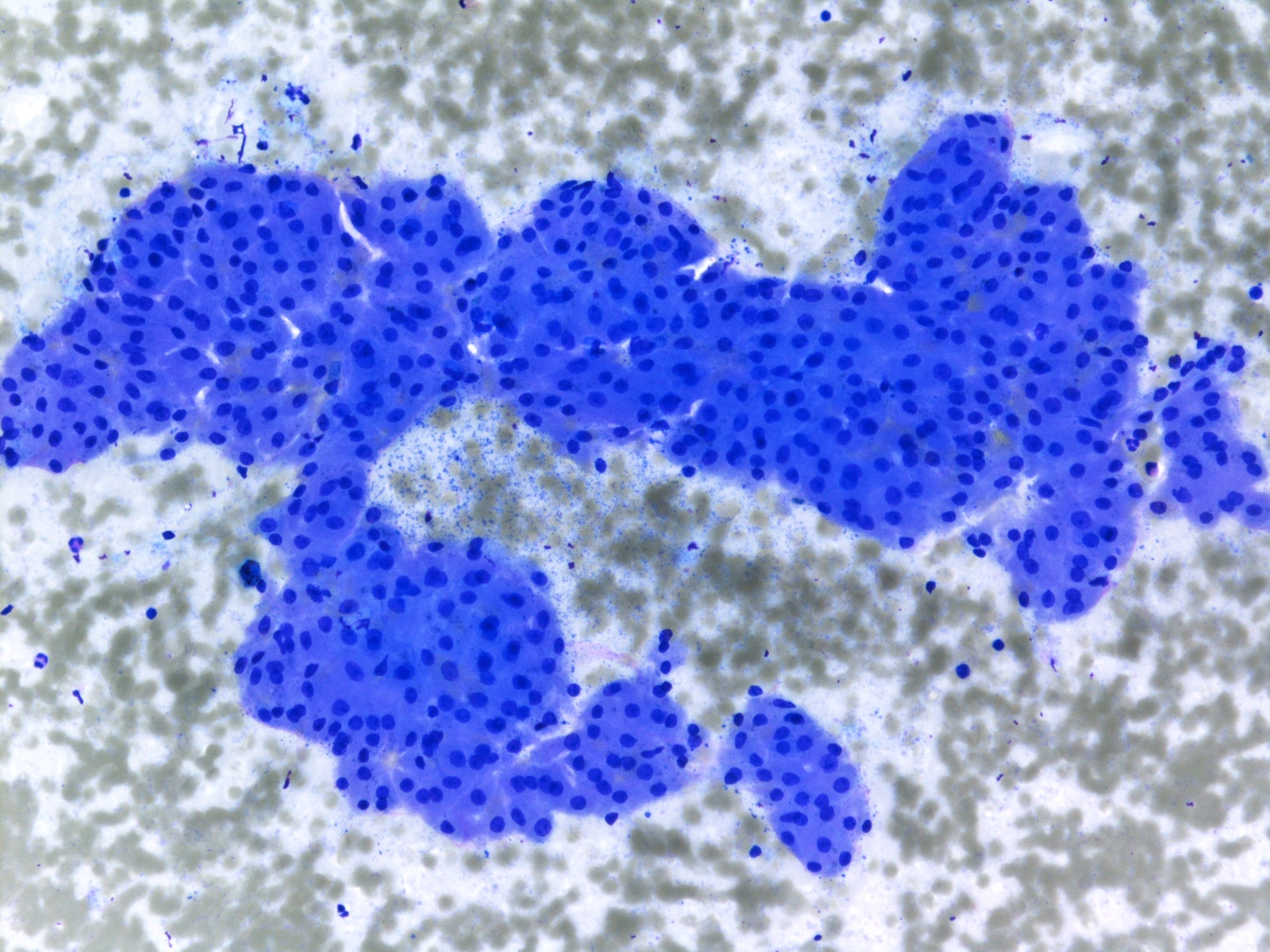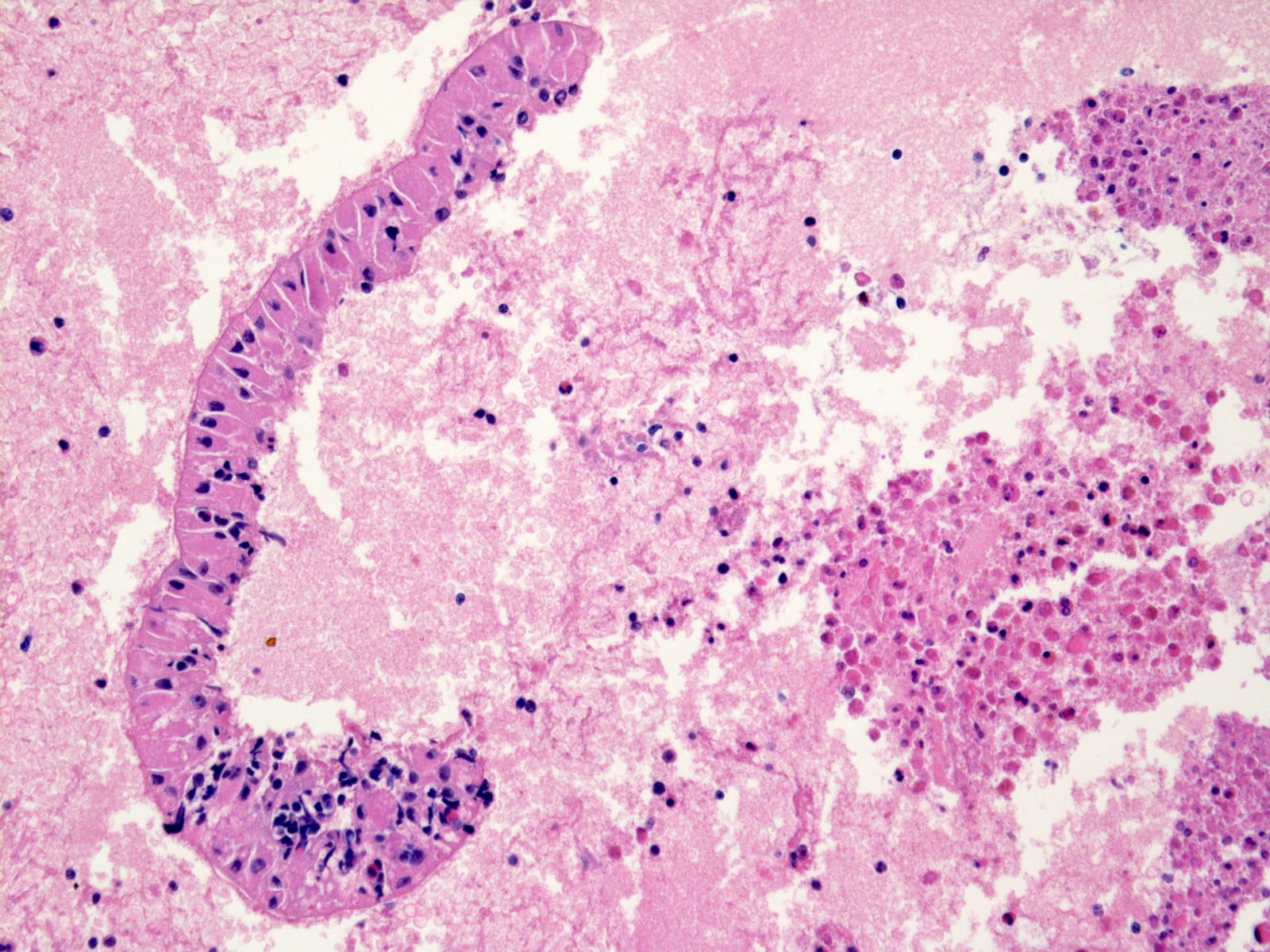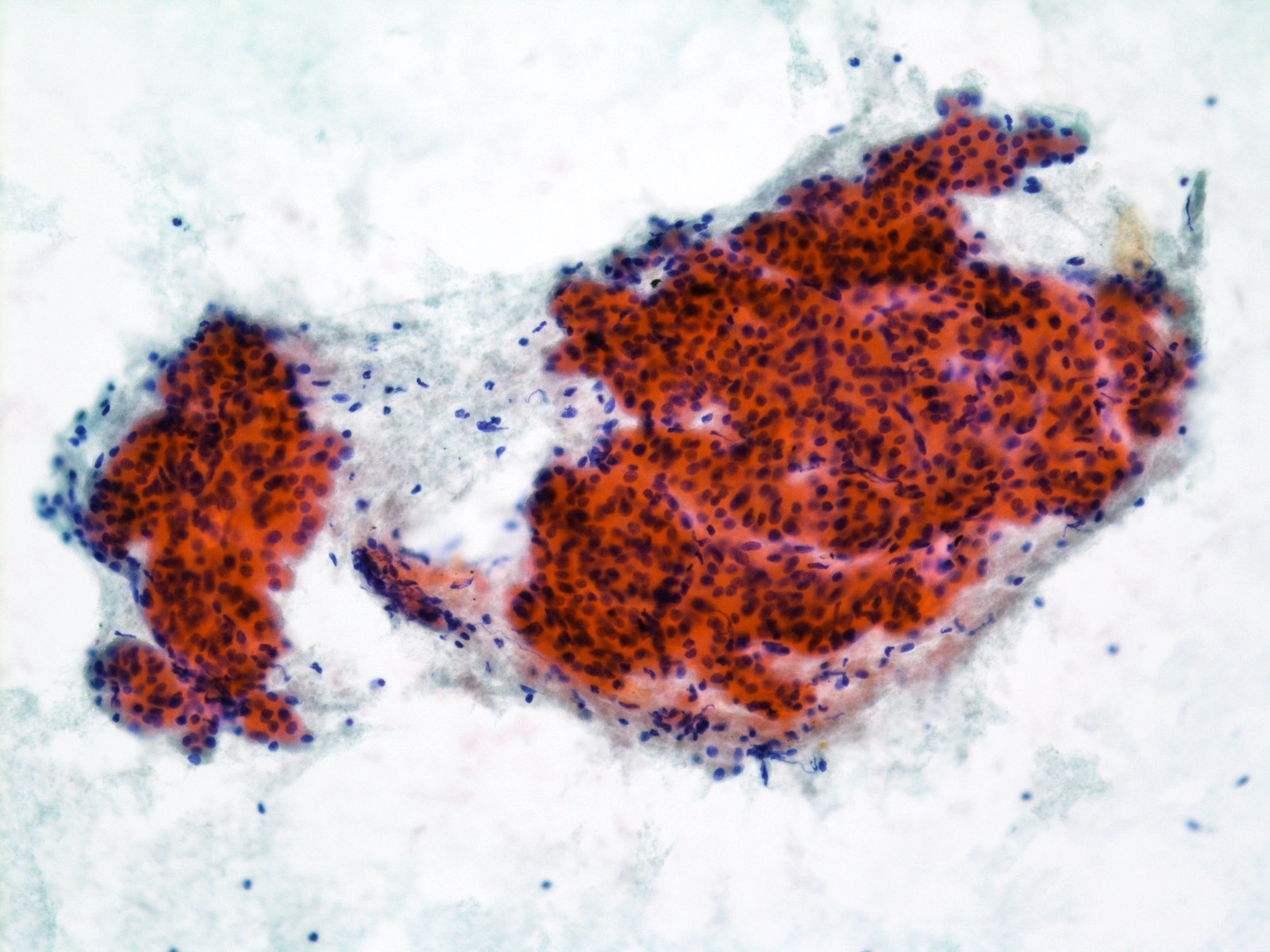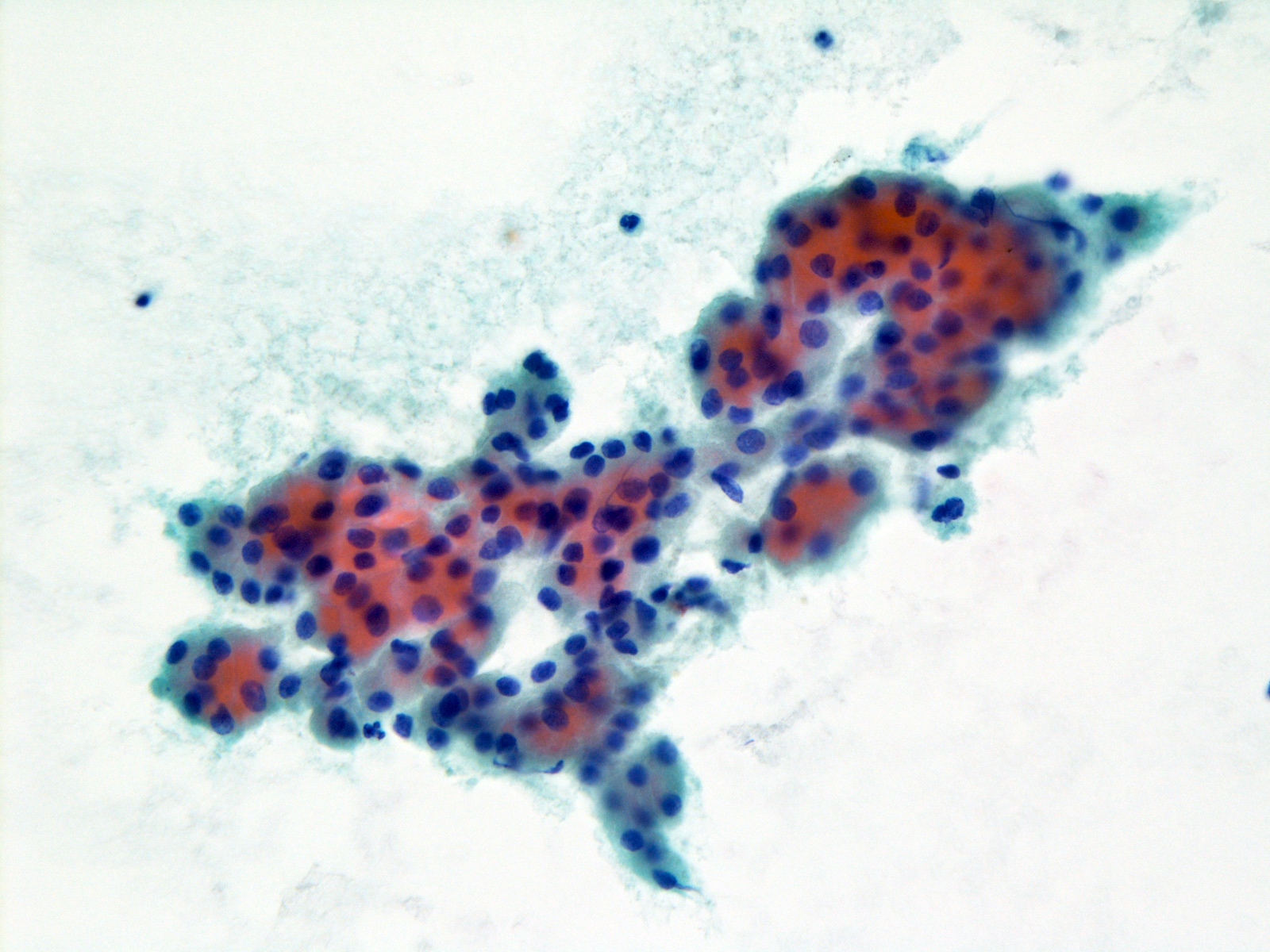Table of Contents
Definition / general | Essential features | Terminology | Epidemiology | CPT coding | Sites | Clinical features | Radiology description | Case reports | Treatment | Cytology description | Cytology images | Videos | Sample pathology report | Differential diagnosis | Additional references | Board review style question #1 | Board review style answer #1 | Board review style question #2 | Board review style answer #2Cite this page: Hang JF. Neoplasm-benign. PathologyOutlines.com website. https://www.pathologyoutlines.com/topic/salivaryglandsneoplasmbenign.html. Accessed May 13th, 2024.
Definition / general
- Fine needle aspiration (FNA) shows characteristic cytomorphologic features of a specific benign neoplasm of the salivary gland (Faquin: The Milan System for Reporting Salivary Gland Cytopathology, 1st Edition, 2018)
Essential features
- Salivary gland FNA diagnostic of a benign neoplasm (pleomorphic adenoma 60 - 70%, Warthin tumor 20 - 30%, other tumors 10%)
- 30 - 40% of all salivary gland FNA
- Estimated risk of malignancy (ROM) by the Milan system: < 5%
Terminology
- Neoplasm: benign (category IVA)
- Specific diagnosis of a benign neoplasm should be provided in this category
Epidemiology
- Salivary gland tumors are uncommon and represent < 2% of all human tumors (Kumar: Robbins & Cotran Pathologic Basis of Disease, 10th Edition, 2020)
- Epithelial tumors account for 80 - 90% and approximately 60% are benign
Sites
- Parotid gland: 65 - 80% of all salivary gland tumors, 70 - 85% are benign (Kumar: Robbins & Cotran Pathologic Basis of Disease, 10th Edition, 2020)
- Submandibular gland: 10% of all salivary gland tumors, 55 - 60% are benign
- Minor salivary glands (including sublingual glands and seromucinous glands of the upper aerodigestive tract): 20% of all salivary gland tumors, 10 - 30% of sublingual gland tumors and 50% of minor salivary gland tumors are benign
Clinical features
- Frequency among all the Milan system categories: 30 - 40%
- Resection rate: 43.5 - 61.4% (Cancer Cytopathol 2020;128:348)
- Risk of neoplasm: > 99% (J Oral Maxillofac Surg 2010;68:2146)
- Real world risk of malignancy:
- With surgical follow up only: 2.4% (1.8 - 3.0%) (Diagn Cytopathol 2020;48:880)
- Overall: 1.5% (Am J Clin Pathol 2019;151:613)
Radiology description
- On ultrasound, benign salivary gland tumors are usually well defined and hypoechoic (Eur J Radiol 2008;66:419)
Case reports
- 12 year old boy with a parotid juvenile sclerosing polycystic adenosis, cytologically mimicking a Warthin tumor (Diagn Cytopathol 2019;47:1208)
- 41 year old woman with a glandular schwannoma at submandibular region, cytologically mimicking a pleomorphic adenoma (Diagn Cytopathol 2015;43:395)
- 53 year old women with Warthin-like variant of mucoepidermoid carcinoma of parotid glands, cytologically mimicking a Warthin tumor (Diagn Cytopathol 2017;45:1132)
- 61 year old man with an epithelioid schwannoma of the facial nerve, cytologically mimicking a parotid pleomorphic adenoma (Diagn Cytopathol 2014;42:58)
- 70 year old man with a cystic pleomorphic adenoma of parotid gland, cytologically mimicking a mucoepidermoid carcinoma (Diagn Cytopathol 2005;32:229)
- 78 year old woman with a pleomorphic adenoma at hard palate, showing predominant plasmocytoid myoepithelial cells and cytologically mimicking a poorly differentiated carcinoma (Diagn Cytopathol 2009;37:56)
Treatment
- Surgery or clinical and radiological follow up
Cytology description
- Pleomorphic adenoma: 60 - 70% of all benign salivary gland FNA
- Mixture of myoepithelial cells, ductal cells and extracellular stroma
- Myoepithelial cells are usually the predominant cell type with various cytomorphology, including round, polygonal, plasmacytoid, spindle, etc.
- Ductal cells show bland cytologic features with organized honeycombing or ductal arrangement
- Extracellular matrix shows characteristic feathery / fibrillary borders and bright magenta color on Romanowsky type stain and gray-green chondromyxoid features on Papanicolaou stain
- Warthin tumor: 20 - 30% of all benign salivary gland FNA
- Sheets of oncocytes and mixed population of lymphocytes in a characteristic dirty proteinaceous background
- Oncocytic sheets show an organized honeycombing or papillary arrangement and are typically cyanophilic at the periphery and bright orange at the center on Papanicolaou stain
- Oncocytes show densely granular cytoplasm, centrally located nuclei and small nucleoli
- Lymphocytes are mostly small mature cells
- Oncocytoma:
- Cellular oncocytic aspirates with very clean background
- Oncocytes show abundant finely granular cytoplasm, centrally placed or eccentric nuclei and occasional distinct nucleoli
- Cellular arrangement can be irregular sheets, small clusters or single cells
- Most FNA of basal cell adenoma, myoepithelioma and cystadenoma should be better classified as salivary gland neoplasm of uncertain malignant potential (SUMP) due to overlapping cytomorphology with other malignant tumors
- Other benign mesenchymal neoplasms:
- Schwannoma: spindle shaped cells with wavy nuclei and bipolar cytoplasmic processes in syncytium-like fragments
- Lipoma: fragments of benign adipocytes with clear cytoplasm and small nuclei
- Hemangioma: bloody aspirates with few groups of bland spindle shaped endothelial cells
Cytology images
Videos
Benign neoplasm 1
Benign neoplasm 2
Sample pathology report
- Submandibular gland, right, fine needle aspiration:
- Satisfactory for evaluation
- Neoplasm: benign
- Pleomorphic adenoma
- Parotid gland, right, fine needle aspiration:
- Satisfactory for evaluation
- Neoplasm: benign
- Warthin tumor
- Parotid gland, left, fine needle aspiration:
- Satisfactory for evaluation
- Neoplasm: benign
- Oncocytoma
Differential diagnosis
- Pleomorphic adenoma:
- Pleomorphic adenoma with squamous or mucinous metaplasia can be falsely interpreted as mucoepidermoid carcinoma
- Pleomorphic adenoma with prominent hyaline globules can be falsely interpreted as adenoid cystic carcinoma
- False negative rate: 3% (25/840) (Cancer Cytopathol 2021;129:43)
- Carcinoma ex pleomorphic adenoma (36%, 9/25)
- Adenoid cystic carcinoma (24%, 6/25)
- Mucoepidermoid carcinoma (12%, 3/25)
- Epithelial myoepithelial carcinoma (8%, 2/25)
- Salivary duct carcinoma (4%, 1/25)
- Malignant peripheral nerve sheath tumor (4%, 1/25)
- Large B cell lymphoma (4%, 1/25)
- Warthin tumor:
- FNA with predominant dirty granular background material and scant epithelial component can be falsely interpreted as necrosis
- Warthin tumor with squamous or mucinous metaplasia can be falsely interpreted as mucoepidermoid carcinoma
- False negative rate: 1.3% (4/304) (Cancer Cytopathol 2021;129:43)
- Mucoepidermoid carcinoma (50%, 2/4)
- Acinic cell carcinoma (50%, 2/4)
- Oncocytoma:
- Low grade carcinomas with oncocytoid features, e.g. acinic cell carcinoma and secretory carcinoma, usually show zymogen granules or secretory globules instead of the mitochondria type fine granules in the cytoplasm
Additional references
Board review style question #1
Board review style answer #1
C. Pleomorphic adenoma. Magenta colored extracellular matrix with feathery / fibrillary borders and intermingled bland myoepithelial cells are characteristic features of a pleomorphic adenoma.
Comment Here
Reference: Neoplasm-benign
Comment Here
Reference: Neoplasm-benign
Board review style question #2
Which salivary gland tumor below should be reported on FNA as "salivary gland neoplasm of uncertain malignant potential (SUMP)"?
- Basal cell adenoma
- Oncocytoma
- Pleomorphic adenoma
- Warthin tumor
Board review style answer #2
A. Basal cell adenoma. Basal cell adenoma shows overlapping morphological features with basal cell adenocarcinoma in FNA. The distinction between these 2 tumors depends on the histological examination to demonstrate tumor invasion. Moreover, pleomorphic adenoma with predominant basal cells and solid / tubular variant of adenoid cystic carcinoma can also cytologically mimic a basal cell adenoma. Therefore, it is recommended to report FNA with basal cell features as SUMP with basaloid features in the Milan system.
Comment Here
Reference: Neoplasm-benign
Comment Here
Reference: Neoplasm-benign



